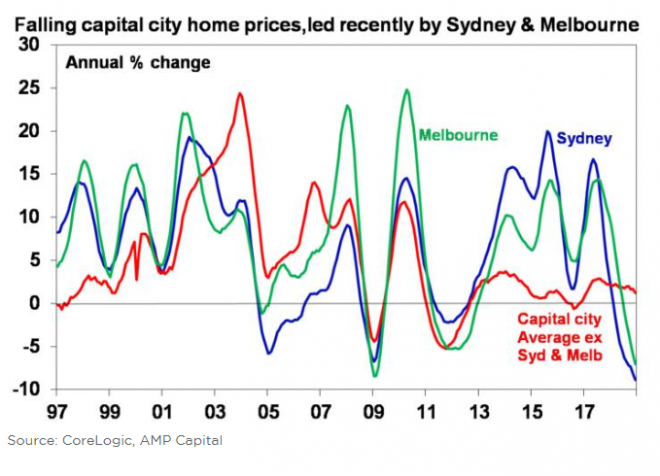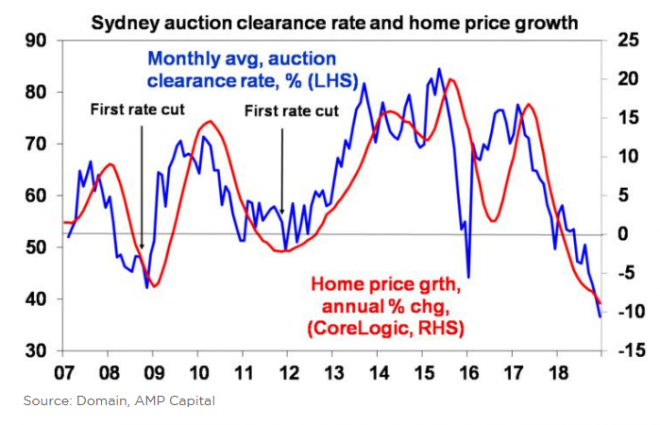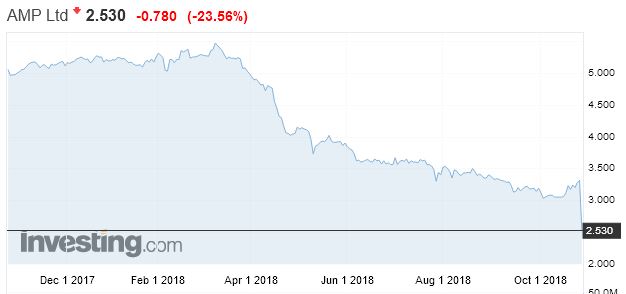Anyone expecting an RBA rate cut to trigger a repeat of the six-year property boom we experienced from 2011 needs to think again, according to one of Australia’s leading forecasters; via InvestorDaily.

Speaking to Investor Daily, AMP Capital chief economist Shane Oliver said he believes Sydney is now about halfway through its correction, with top-to-bottom house price falls to reach 25 per cent in the nation’s biggest city.
“Melbourne prices have come down by around 10 per cent. Like Sydney, I think they will come down by 25 per cent as well, so they’re not quite halfway through the downturn,” he said. “There is a wealth effect coming through from the price falls we have already seen and a wealth effect still to come from further falls in house prices.”
The property slowdown has also forced lenders like ING and Adelaide Bank to reduce credit or small businesses borrowing against their residential property.
ING has banned borrowers from using their homes as security for business loans amid fears of negative equity as property prices continue to fall.
A credit squeeze in the small business sector, coupled with the “wealth effect” of falling property prices, which curtails household consumption, could have serious implications for the Australian economy.
RBA assistant governor Michele Bullock gave a speech in Perth this week in which she stated that the wellbeing of households and businesses in Australia depends on growth in the Australian economy.
“And a crucial facilitator of sustained growth is credit – flows of funds from people who are saving to people who are investing.”
The Reserve Bank is banking on growth of 3 per cent by the end of 2019. But AMP Capital’s Mr Oliver believes a reduction in consumer spending and reduced construction activity related to housing suggests growth could be closer to 2 per cent.
“If SMEs struggle to get credit, then it could be worse than that,” he said.
“I’m probably in the more negative camp on the wealth effect and I think the evidence is there. RBA governor Philip Lowe gave a speech two weeks ago where he said that a 10 per cent decline in net housing wealth would reduce consumer spending by 0.75 per cent in the short term and 1.5 per cent in the longer term.
“A 10 per cent fall in net housing wealth would be equivalent to a 7 per cent fall in actual house prices, given a degree of gearing. Net housing wealth is about 75 per cent of total housing wealth, so if you’ve got a 10 per cent fall in total housing wealth, it implies a bigger impact of around 2 per cent in consumer spending.”
Unemployment is a key indicator for measuring the impact of these effects on the economy. Mr Oliver predicts the unemployment rate will increase from 4.9 per cent to 5.5 per cent by the end of the year.
Research released by the Reserve Bank of Australia shows that the central bank’s decision to begin cutting rates in November 2011, from 4.75 per cent to 1.5 per cent today, had a direct influence on booming property prices.
The price of credit has come down significantly over the last six years, given the 3.25 per cent reduction in the official cash rate over that time.
House prices peaked in mid-2017 and have declined by approximately 7 per cent nationally since then. In Sydney, prices have come down by around 12 per cent from their peak.
The next rate cut by the Reserve Bank, which some believe could come as early as May, won’t have the same impact as it did eight years ago, Mr Oliver said.
“It will provide some help to stabilise the market. But I don’t think it’s going to provide the same stimulus as it did in 2011. Household debt-to-income levels are much higher now. The banks also have much tighter lending standards than they did in 2011.
“I don’t think we’ll be off to the races again.”









